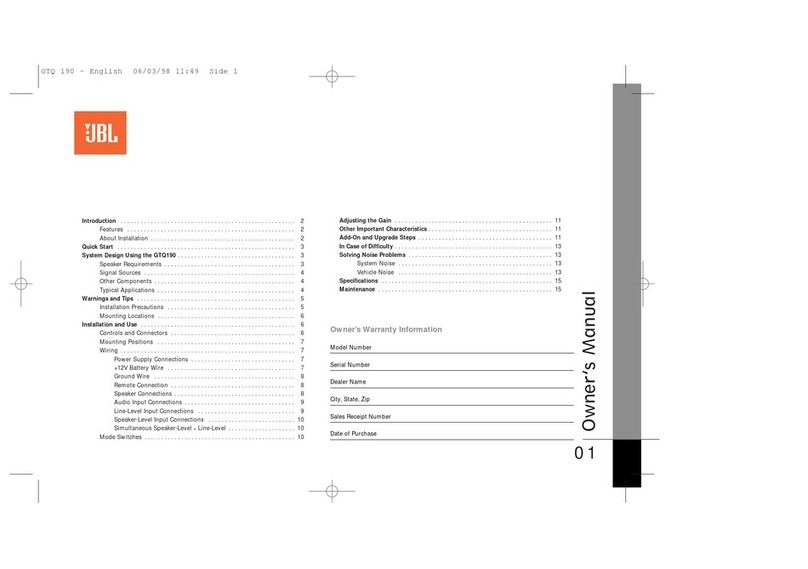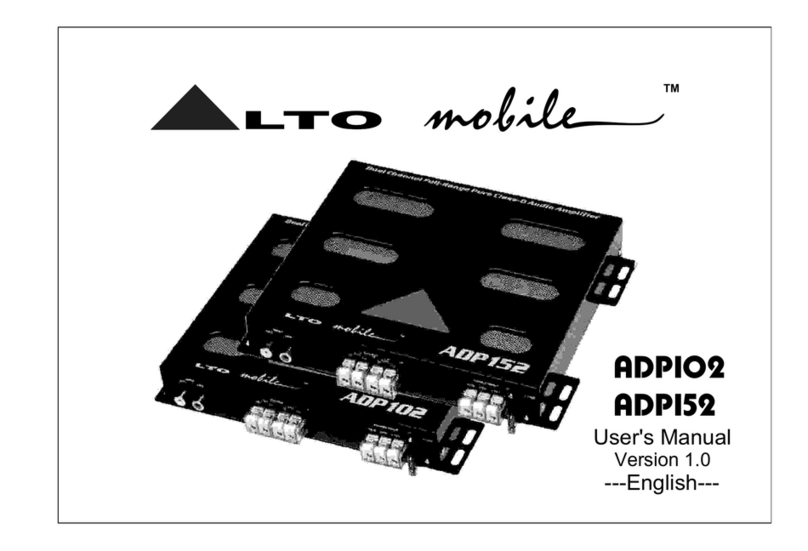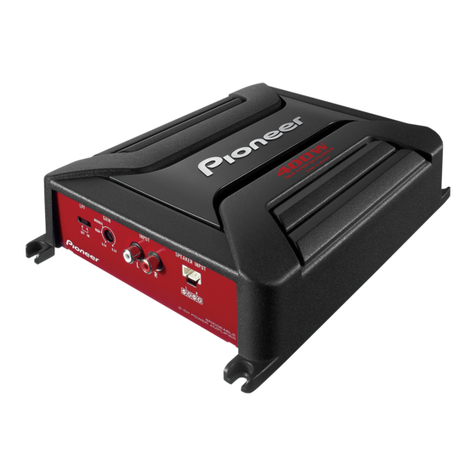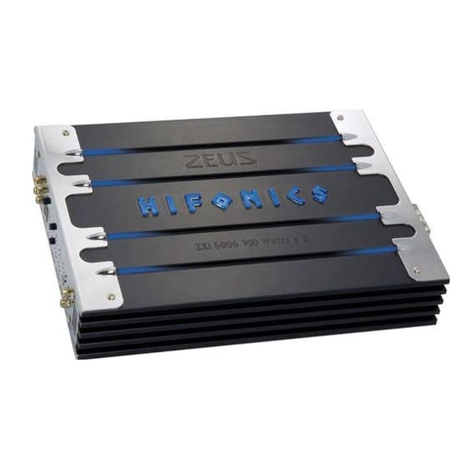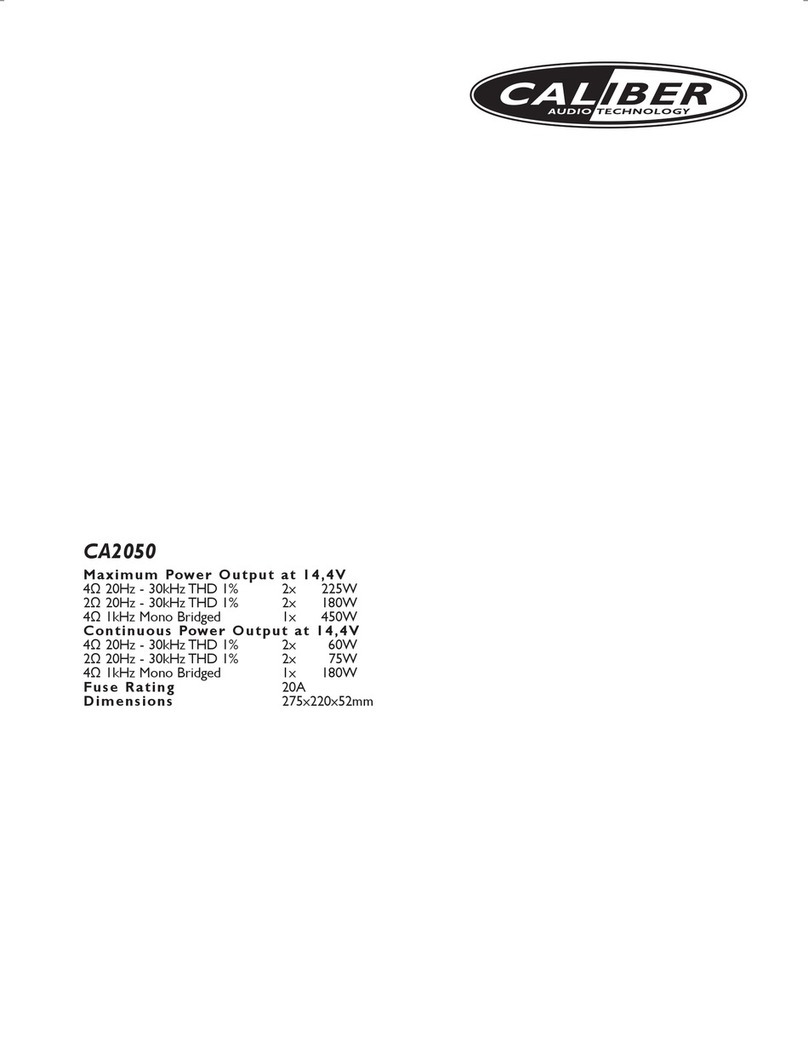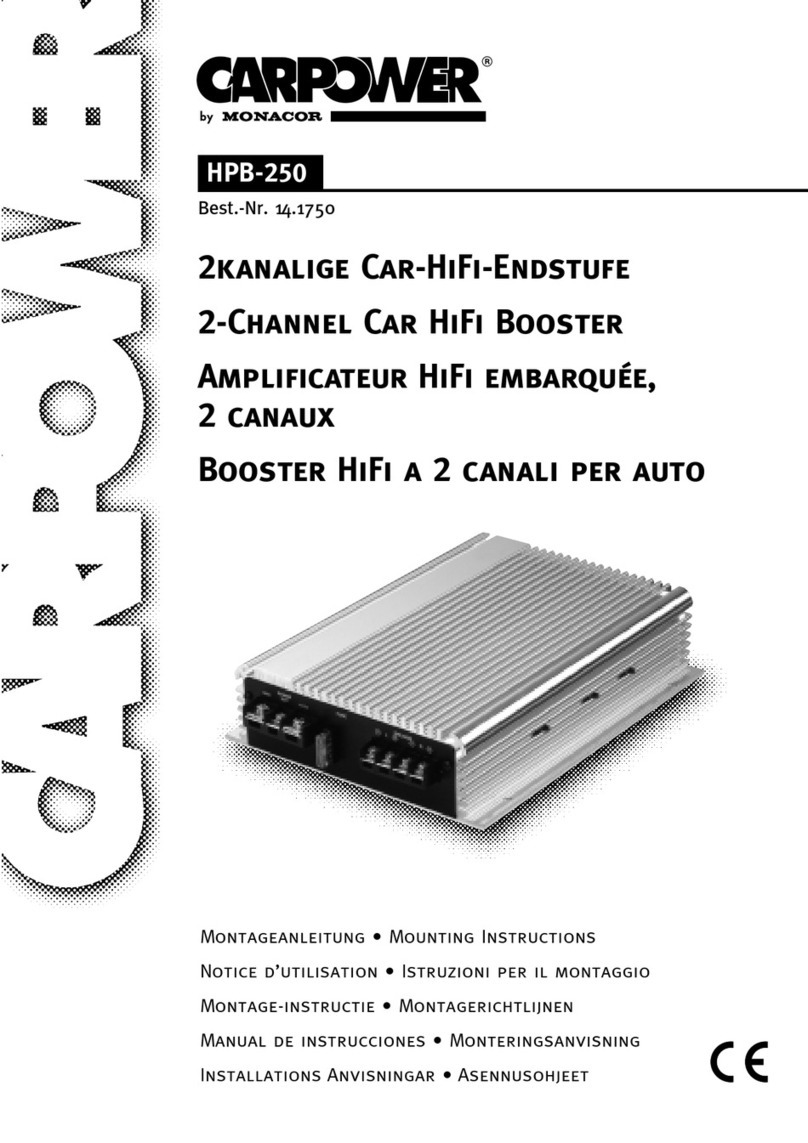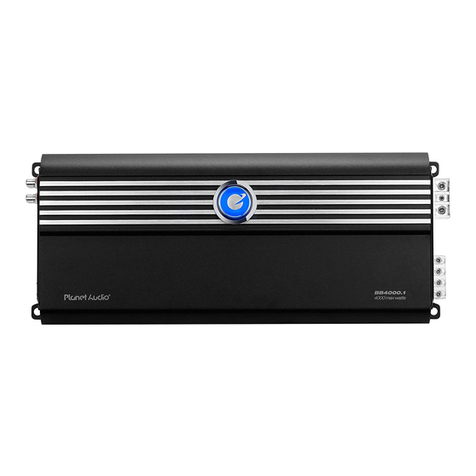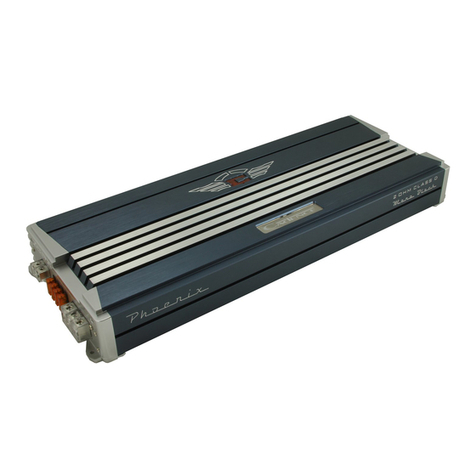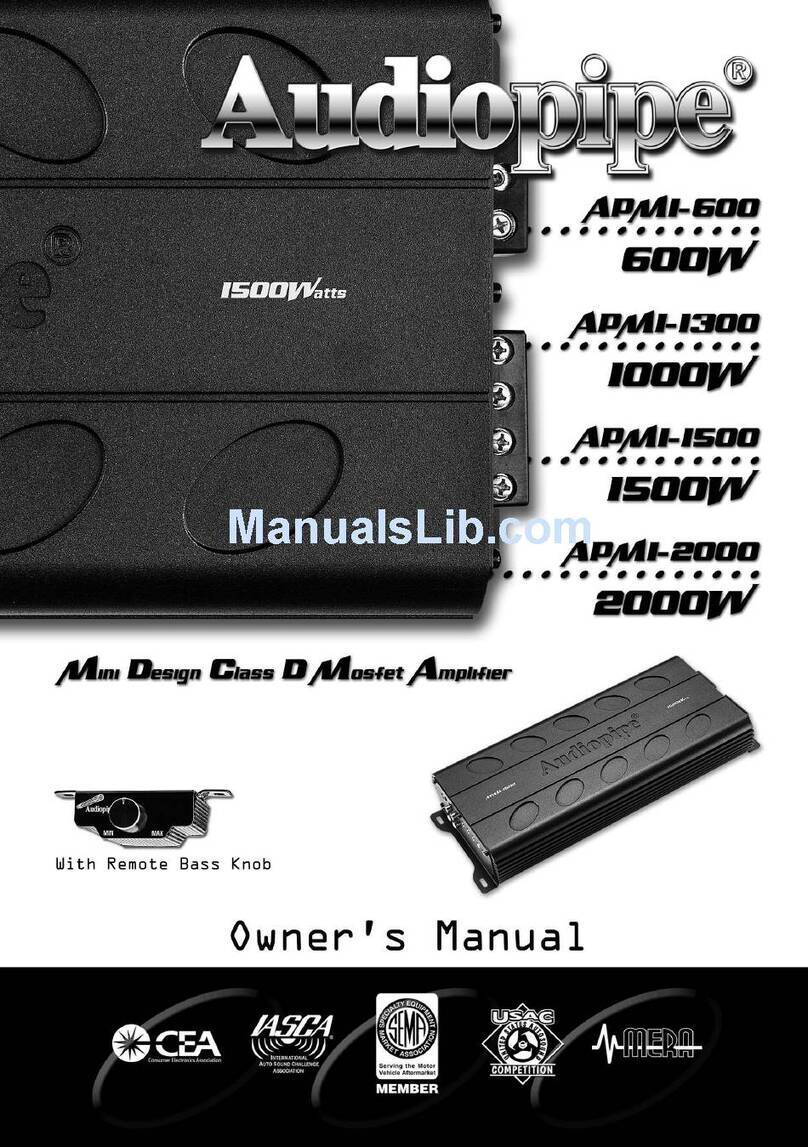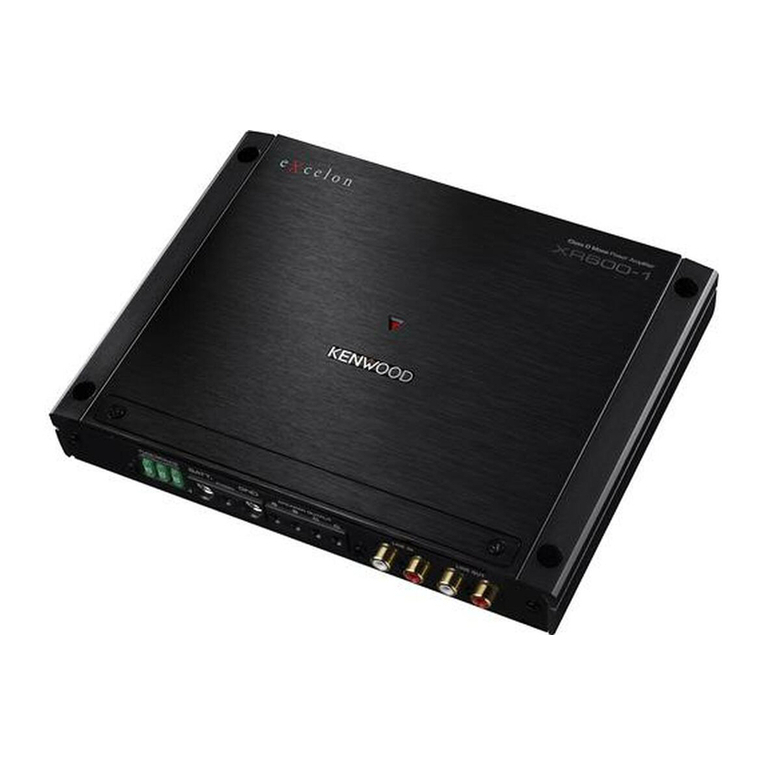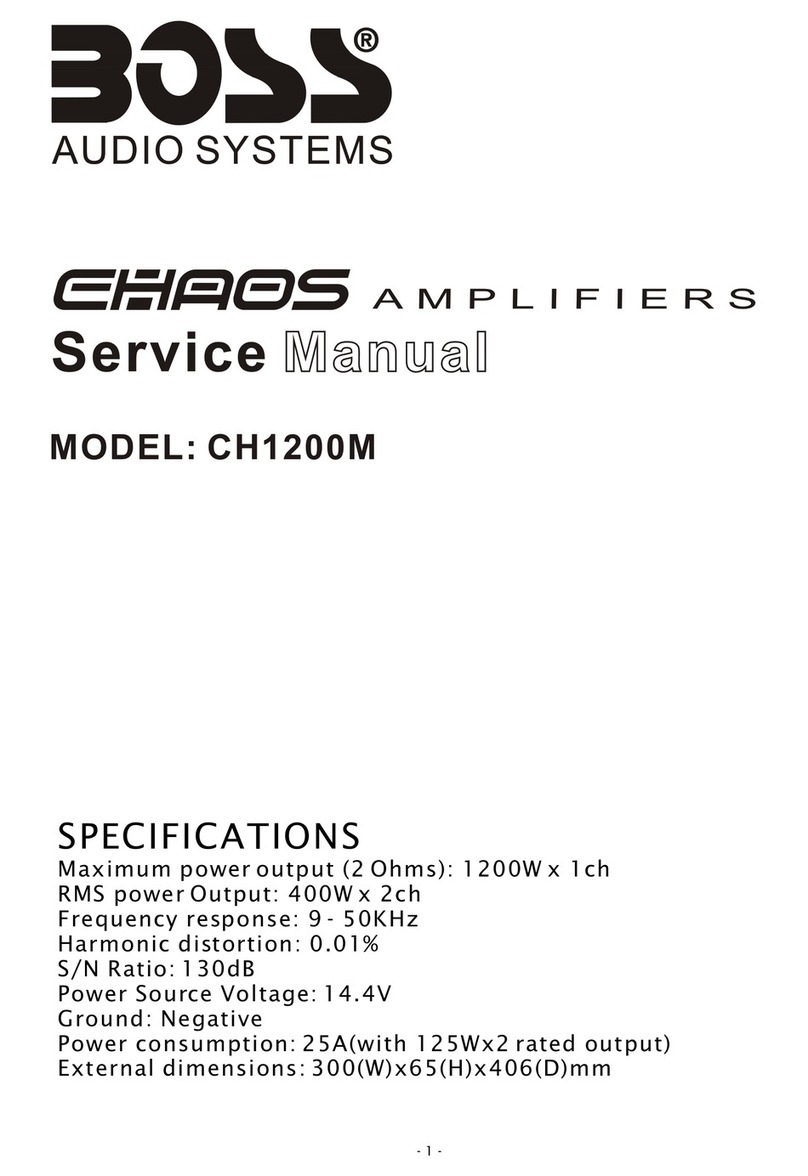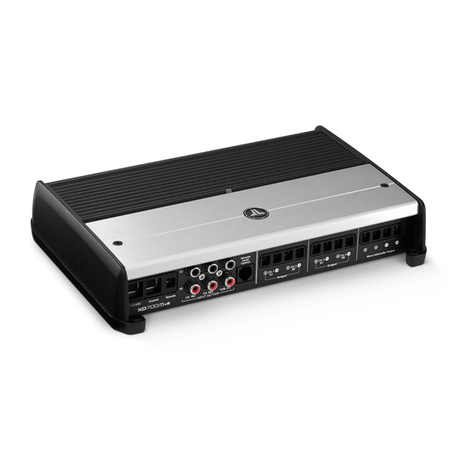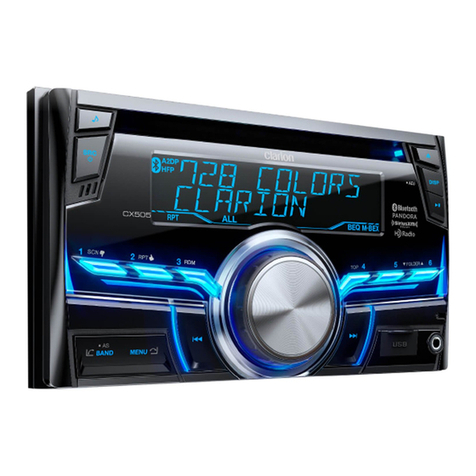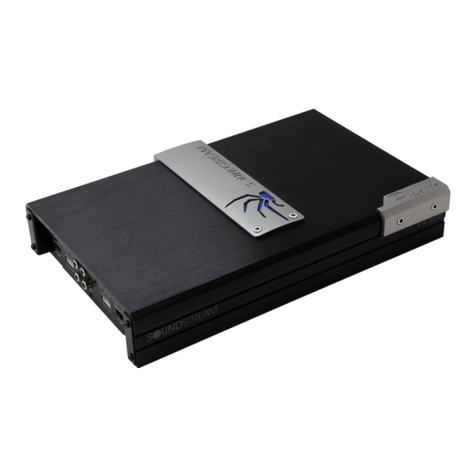In Phase IPA 2041 User manual

To ensure maximum performance and safety .
please follow this manual. Please retain the
manual for future reference after installation.
Instruction Manual
IPA 601 IPA 1001 IPA 1601
IPA 1041 IPA 2041


NOTE : Specifications & design subject to change without notice for improvements.
SPECIFICATION
AMPLIFIER
2 Ohm RMS Output
4 Ohm RMS Output
Low Pass Filter (Variable)
High Pass Filter (Variable)
Subsonic Filter
Maximum Output Power
Fuse Rating
Frequency Response (-1dB)
Signal To Noise Ratio ('A' WTD)
Input Sensitivity
Input Impedance
Operation Voltage (negative Ground)
Speaker Impedance @ Stereo Driven
Dimensions (250 X 55.5 X D)mm 160
N/AN/A
75W x 2
100W x 2
50Hz-250Hz
80Hz-1.2kHz
20Hz-50Hz
600 Watts
20 A x 1
10Hz-30kHz
>100dB
200mV-6V
22k Ohm
DC 12V
4 Ohm
Bass Level Remote Control(16.4ft)
IPA 1001
260
150W x 2
200W x 2
50Hz-250Hz
80Hz-1.2kHz
20Hz-50Hz
1000 Watts
20 A x 2
10Hz-30kHz
>100dB
200mV-6V
22k Ohm
DC 12V
4 Ohm
IPA 1601
380
300W x 2
400W x 2
50Hz-250Hz
80Hz-1.2kHz
20Hz-50Hz
1600 Watts
YES
30 A x 2
10Hz-30kHz
>100dB
200mV-6V
22k Ohm
DC 12V
4 Ohm
IPA 601
4 Ohm Bridge Output 200W x 1 400W x 1 800W x 1
1

NOTE : Specifications & design subject to change without notice for improvements.
SPECIFICATION
AMPLIFIER
2 Ohm RMS Output
4 Ohm RMS Output
Low Pass Filter (Variable)
High Pass Filter (Variable)
Subsonic Filter
Maximum Output Power
Fuse Rating
Frequency Response (-1dB)
Signal To Noise Ratio ('A' WTD)
Input Sensitivity
Input Impedance
Operation Voltage (negative Ground)
Speaker Impedance @ Stereo Driven
Dimensions (250 X 55.5 X D)mm
IPA 1041
280
N/A
75W x 4
80Hz-1.2kHz
100W x 4
50Hz-250Hz
1000 Watts
20 A x 2
10Hz-30kHz
>100dB
200mV-6V
22k Ohm
DC 12V
4 Ohm
Bass Level Remote Control(16.4ft)
IPA 2041
380
N/A
N/AN/A
150W x 4
80Hz-1.2kHz
200W x 4
50Hz-250Hz
2000 Watts
30 A x 2
10Hz-30kHz
>100dB
200mV-6V
22k Ohm
DC 12V
4 Ohm
4 Ohm Bridge Output 200W x 2 400W x 2
2

free installation.
Congratulations on your Purchase
• Four Class''AB'' High-Current DualDiscrete Drive Stages.
• Class ''AB''Technology MOSFET PWM Power Supply.
• Bridgeable &TRI-Mode Operation.
• Continuously Variable 12dB/Octave HighPass & 12dB
/Octave Low PassCrossover.
• Subwoofer Variable Crossover forDeep Bass Control.
• Enhanced BassBoost +12dB @50Hz.
• Silver PlatedRCA, Power & Speaker Terminal.
• Soft Start& Muting.
• Overload, Thermal and ShortCircuit Protection.
• Power &Protection indicator.
• Bass LevelRemote Control(16.4Fit)
Features
Your new high fidelity bridgeable/stereo amplifier is designed to deliver maximum enjoy
ment and oneyear of troublefree service. Pleasetake a fewmoments to readthis manual
thoroughly. It will explain the features and operation of your unit and help insure trouble
Precautions: Read First!
authorized installer. It's your car!
• If afterreading the directionsyou feel uncomfortableabout installing theamplifier in your
car, or not equipped or competent to do so, you should have the amplifier installed by an
• Negative battery terminal must be disconnected before any electrical connections are made.
• Be surechoose a locationthat provides substantialventilation for theamplifier. The most
preferred locations wouldbe in your car's trunk, under the front seats or on the back wall
of a truck.
• The location chosen should provide at least 2" of clearance above the amplifier for adequate
ventilation.
• Ifthe amplifier is to be mounted vertically be sure that it is in aplace where adequate air
will flow alongthe length ofits heatsink finsfor cooling.
• NEVERmount theamplifier upside down,this willcause theheat torise backinto the
amplifier causing thermalshutdown or possiblepermanent damage.
• NEVERmount theamplifier ina location that is subject todirect sunlightor exposedto
moisture.
• Be sureto mount theamplifier to astrong, solid surfacewhich will notgive way underthe
stress of asudden stop oraccident.
• Make sure that the mounting screws will not penetrate the gas tank, brake and fuel lines,
wiring or othercritical parts ofyour car wheninstalled.
3

• NEVER operate the amplifier without the proper power and ground wire, 10 gauge minimum.
• NEVER operate the amplifier without proper fusing. Fuse holder must be located with in
0.5 meters from the battery. This fuse is to protect the car not the electronics. In case of a
short, the fuse will blow instead of the wire burning up. Using other than the recommended
fuse ratings at the battery and at the amplifier may cause damage to the amplifier and will
• Do not run wiring underneath or outside the car since exposure to the elements may cause
the insulation to deteriorate rapidly, resulting in short-circuits and/or intermittent operation.
• To help minimize interference, it is best to run the power cables along the opposite side
.
• Whenever wires pass through metal, rubber or plastic grommets must be used to prevent
• Whenever possible, use cable ties, mounting clamps and similar wiring aids. (available
from an electrical supply or auto parts store) Adding stress relief loops to wiring is also
• It is best to test the system before the amplifier is mounted and interior of car is reassembled.
• If the temperature inside your car reaches extreme levels(such as sitting locked up for
several hours in the hot sun or exposed to a very cold winter's day)the amplifier may go
into protection mode and shut off. Leave the unit off until the ambient temperature returns
• The amplifier operates with any vehicle using a 12 volt negative ground system. If you are
not sure of the type of electrical system in your vehicle, consult your authorized dealer or
• NEVER ground the speaker leads and NEVER allow the speaker leads to come in contact
• Remote turn on wire must be switched by the radio does not have a remote turn on or
antenna output, connect to wire that has a positive 12 volts when the key is turned to the
• Do not listen to high volumes for extended periods of time or hearing damage may occur.
4
CONTINOUS EXPOSURETO SOUNDPRESSURE LEVELSOVER 100dBMAY
CAUSE PERMANENT HEARINGLOSS. HIGH POWEREDAUTOSOUND SYSTEM
SENSE ANDPRACTICE SAFE SOUND.
MAY PRODUCESOUND PRESSURE LEVELS WELLOVER 130dB. USE COMMON
void your warranty.
all cables should be run beneath carpets and inside trim pieces.
from the audio cables
the metal from wearing through the installation and causing a short.
advisable to prevent straining or breakage.
to normal.
qualified mechanic.
with each other. Speaker wire should be 18 gauge or larger.
accessory. If the amplifier does not turn off the battery will die.

INSTALLATION
1. Afterreading precaution, decide where you are going to install the unit. Also, see Fig.1.
2. Once thelocation has beendetermined, place theamplifier into position.Using a felttip
pen or pencilmark the fourholes to be drilled for mounting. NEVER use theamplifier as
a template for drilling. It is very easy to damage the amplifier surface in this manner.
3. Remove amplifier. Drill four 3.5 m/m holes into mounting surface. If you want to mount
4. If possible, test the system to ensure it is operating correctly before final mounting of
5.
INSTALLATION DIAGRAM
MOUNTING:
Mount the amplifierusing the supplied4 self tappingscrews.
the amplifier to MDF or wood panel, drill four 3.0m/m diameter holes into mounting surface.
the amplifier.
FIG.1
SELF TAP SCREWS
5

POWER CONNECTIONS
CONNECTIONS
INPUT CONNECTIONS
It is important to have good quality power and ground connections. Remember, to complete
an electrical circuit, the ground connection is just as important as the positive power
connection. Before any power connections are made, disconnect the ground cable at the
When the power supply lead, memory backup lead or ground lead are extended use a 5mm²
(AWG5) or larger automotive grade cable which will withstand friction and heat to safe
GND = Connect the proper gauge ground wire to the amplifier "GND" terminal. Locate the
position on the chassis of the car to which the amplifier is to be grounded. The surface must
be free from any paint or dirt. This can be accomplished with a small grinding bit, sand
paper or wire wheel. NOTE: Do not ground the amplifier to the "frame of the car. The frame
on most cars and trucks is not grounded to the chassis(body). Use Solder or a clamp ring to
connect the ground wire. Pre-drill the prepped chassis to bolt the ground ring terminal with
nut, bolt and lock washers. Insulate metal and connector with paint or silicon to prevent
rust and oxidation. Silicon also works great to prevent nuts and bolts from working loose in
a harsh environment of an automobile. Upon completion of the ground connection, grab
wire or connector and confirm that it is a solid connection. To prevent engine noise, it is
REM = Connect the remote wire (power antenna output) from the head unit to the remote
turn-on wire of the amplifier. If the head unit is not equipped with a remote/antenna output,
locate a wire that is controlled by the accessory position of the key. It is important to have
the amplifier turn off with the radio or key. If the amplifier remains on, the result will most
12V = Connect the proper gauge power wire to the amplifier "B+" terminal. Run wire to
wards the fuse holder that is no greater then 0.5 meters from the battery. Remember, the
fuse is to protect the safety of the car in the case of a short. Connect fuse holder to battery,
6
This amplifier will accept low level inputs only. Low level is the same as line level. The low
level signal is carried through RCA cables. It is preferred to use low level inputs to the amplifier
if the head unit is equipped with the low level outputs. If not, you can use a "high to low
Connect the low level/line level RCA cables from the head unit, or signal processor, to the
converter" available throughyour local caraudio shop.
line level inputon the amplifier. See Fig.2system wiring diagrams.
battery.
grade against fires occurring as a result of short-circuiting.
recommended to ground the head unit and other audio electronics in the same location.
likely be a dead battery.
but do not install fuse at this time.

L
R
MIN MAX
LEVEL SUBSONIC
50Hz20Hz
BASS BOOST
12dB0dB 250Hz50Hz 1.2kHz80HzFULL
L.P.F H.P.F
CROSS OVER
LINE OUTPUTLINE INPUT
L
R
L
R
MIN MAX
LEVEL SUBSONIC
50Hz20Hz
BASS BOOST
12dB0dB 250Hz50Hz 1.2kHz80HzFULL
L.P.F H.P.F
CROSS OVER
LINE OUTPUTLINE INPUT
L
R
2CHANNEL SYSTEM WIRING DIAGRAM
7
AUTO - ANTENNA LEAD
CH1 CH2
CAR STEREO HEAD UNIT
B+B+GNDGND REMREM

LL
RR
MINMIN MAXMAX 50Hz50Hz12dB12dB0dB0dB 250Hz250Hz 80Hz80HzFULLFULL FULLFULL
LEVELLEVEL LEVELLEVELSUPER
BASS
SUPER
BASS
SUPER
BASS
SUPER
BASS
L.P.FL.P.F L.P.FL.P.FH.P.FH.P.F H.P.FH.P.F
CROSS OVERCROSS OVER CROSS OVERCROSS OVER
REARREAR
LINE INPUTLINE INPUT
FRONTFRONT
LINE INPUTLINE INPUT
LL
RR
1.2kHz1.2kHz 80Hz80Hz 1.2kHz1.2kHz 50Hz50Hz 250Hz250Hz MINMIN MAXMAX12dB12dB0dB0dB
INPUT MODEINPUT MODE
4CH4CH2CH2CH
4CHANNEL SYSTEM WIRING DIAGRAM
8
CH3 CH4CH2CH1
AUTO - ANTENNA LEAD
CAR STEREO HEAD UNIT
B+B+GNDGND REMREM

FUSE
ON
PROT
B+GND REM LEFT RIGHT
BRIDGED
POWER SPEAKER
FUSE
ON
PROT
B+GND REM LEFT RIGHT
BRIDGED
POWER SPEAKER
FUSE
ON
PROT
B+GND REM LEFT RIGHT
BRIDGED
POWER SPEAKER
FIG.3
This amplifier can operate in one, two or three channel mode. The minimum impedance for
single channel (bridged/mono) operation is 4 or 8 ohms. Tri channel power is referred to
stereo and mono at the same time. Minimum impedance remains the same for three channel
(front /subwoofer) systems as long as proper passive crossovers are used. Connect right
and left speaker wire to corresponding speaker output terminals of the amplifier. Be sure to
have the positive wire from the speaker connected to the positive speaker terminal of the
amplifier and the negative wire from the speaker must connect with the negative speaker
terminal of the amplifier. Reversing any of these connections will result in the speaker cones
moving out of phase whichcauses bass cancellation. See Fig.3 Speaker Output Connections.
SPEAKER CONNECTIONS
2 CHANNEL SPEAKER WIRING DIAGRAM
9
1 SPEAKER BRIDGED
2 SPEAKER STEREO
3 SPEAKER TRI MODE
4 - 8 Ohm
1CH
2 - 4 Ohm
1 CH 2 CH
WOOFER 2CH+1CH
4 - 8 Ohm
2 CH
3 CH
1 CH 4 - 8 Ohm

ON
PROT
B+GND REM FL FR RL RR
POWER SPEAKER
BRIDGED BRIDGED
FUSE
ON
PROT
B+GND REM FL FR RL RR
POWER SPEAKER
BRIDGED BRIDGED
FUSE
ON
PROT
B+GND REM FL FR RL RR
POWER SPEAKER
BRIDGED BRIDGED
FUSE
ON
PROT
B+GND REM FL FR RL RR
POWER SPEAKER
BRIDGED BRIDGED
FUSE
10
2 SPEAKER BRIDGED
SUB WOOFER
3 CH
4-8 Ohms
2 CH1CH
2 SPEAKER + 1 SUBWOOFER
2-4 Ohms
4 SPEAKER STEREO
2-4 Ohms
4 CH
4-8 Ohms
5 CH
4-8 Ohms
6 CH
4-8 Ohms
6 SPEAKER HEX MODE
4 CHANNEL SPEAKER WIRING DIAGRAM
SPEAKER CONNECTIONS
4-8 Ohms
1 CH 2 CH
3 CH
2 CH1CH
4 CH
3 CH
2 CH1CH
FIG.3

L
R
MIN MAX
LEVEL SUBSONIC
50Hz20Hz
BASS BOOST
12dB0dB 250Hz50Hz 1.2kHz80HzFULL
L.P.F H.P.F
CROSS OVER
LINE OUTPUTLINE INPUT
L
R
LL
RR
MINMIN MAXMAX 50Hz50Hz12dB12dB0dB0dB 250Hz250Hz 80Hz80HzFULLFULL FULLFULL
LEVELLEVEL LEVELLEVELSUPER
BASS
SUPER
BASS
SUPER
BASS
SUPER
BASS
L.P.FL.P.F L.P.FL.P.FH.P.FH.P.F H.P.FH.P.F
CROSS OVERCROSS OVER CROSS OVERCROSS OVER
REARREAR
LINE INPUTLINE INPUT
FRONTFRONT
LINE INPUTLINE INPUT
LL
RR
1.2kHz1.2kHz 80Hz80Hz 1.2kHz1.2kHz 50Hz50Hz 250Hz250Hz MINMIN MAXMAX12dB12dB0dB0dB
INPUT MODEINPUT MODE
4CH4CH2CH2CH
11
ADJUSTMENTS
1.Set to the "H.P.F" position when the amplifier is used to drive a tweeter/midrange system.
The frequencies below the crossover point will be attenuated at 12dB/octave. Permits
adjustment of the crossover frequency ,by rotating the knob to select any frequency
2.Set to the "L.P.F" position when the amplifier is used to drive a subwoofer. The frequencies
above the crossover point will be attenuated at 12dB /octave. Permits adjustment of the
crossover frequency, by rotating the knob to select any frequency between 50Hz to 250Hz
3.Set to the "OFF" position when the amplifier will be used for driving full-range speakers.
The full frequency band width (20Hz - 20kHz) will be output to the speakers without high
4.Level adjustment-The sensitivity adjustment is to allow the amplifier to work with many
different brands of head units. It allows input signal to vary between 350 millivolts to 5
volt from the head unit or other signal processor. Start by setting the sensitivity adjustment
to the "MIN" (3 volts).Using a cassette or compact disc that you are familiar with ,turn on
head unit to the 3/4 volume setting. Slowly turn up sensitivity adjustment towards the
"MAX" (200 millivolts) using a flat head screw driver. Stop turning on the onset of distortion
and turn back just a slight. The 3/4 volume setting is now the "maximum" volume for the
head unit. The goal is to keep the level control to the lowest setting yet still have enough
signal to drive the amplifier. This is done to prevent over driving the amplifier and to keep
system noise to a minimum. It is important not over drive speakers (at point of distortion)
this will cause permanent damageto the speakers. Also, if the amplifier itself is over driven,
5.The "BASS" function can be selected to increase low frequency response output, or
decrease frequency response output. The "BASS" function will be working at only "OFF"
between 80Hz to 1.2kHz as the crossover point.
as the crossover point.
or low frequency attenuation.
it could be damaged.
or "L.P.F" position.
• The BASS isadjustable from 0 ~ 12dB boost at 50Hz.
FRONT PANEL

12
This section providesyou with acatalog of amplifiersymptoms and theirprobable causes
and solutions. Beforeyou consult thislisting, make surethe vehicle's electricalsystem is
working properly byverifying that otherelectrical items (e.g. headlights, windows,etc.)
Still function correctly.
TROUBLE SHOOTING GUIDE.
No Audio Low or N.C Remote
Turn-on connections
Blown Fuse
Power wires not connected
Blown or non speakers
connected
Check remote turn-on voltage at
amp and head unit
Replace with new fast-blow fuse
Check butt splices or solder joints
Check ground and battery
connections
Use VOM or DVM to measure speaker
coil
impedance; check speaker wiring
connections
SOLUTIONPROBABLE CAUSE
SYMPTOM
See adjustment procedure and check
each step;
Inspect each speaker for damage
and repair or replace suspected
component
Refer to head unit owner's manual
Input Sensitivity not set
properly
or damaged speaker cones
Low turn-on voltage
Distorted Audio
Audio Level Low Mute circuit on head
unit is on.
Check electrical system for low
voltage;
Check ground connection
Audio Lacks Speakers wired with wrong
polarity, causing
cancellation of bass
frequencies
Check polarity of wires from
amplifiers to each speaker as defined
by the system design
Check battery voltage at amplifier
during operation
External Fuse
Blowing
Incorrect wiring or short
circuit
Refer to electrical installation and
check each installation step
Whining noise
on audio with
engine running
Amplifier is picking
up alternator noise
Install an in-line noise filter on the
head unit's power wire; Check
alternator routing diodes or voltage
regulator for proper operation. Check
all grounds , battery voltage, and
RCA cables
Ticking noise on
audio with
engine
running
Amplifier is picking up
radiated spark noise
Check RCA audio cable; Install an
in-line noise filter on the head unit's
power wire. Check spark plug wires.


Features and Specifications of the products described or illustrated in this manual are correct at the time of the printing but could change as production
changes occur without notice. In Phase, XT and 'In Life In Tune' are registered Trademarks of In Phase International Ltd, unless otherwise stated. No part
of this production may be reproduced without written permission from In Phase International Ltd. All Images and designs are the Intellectual Property of
In Phase International Ltd 2008
www.inphaseaudio.co.uk

IPA 601 IPA 1001 IPA 1601
IPA 1041 IPA 2041
Bedienungsanleitung
Fur beste Leistung und sicheren Betrieb befolgen
Sie bitte alle Hinweise in dieser Bedienungsanleitung.
Bitte bewahren Sie die Bedienungsanleitung fur
spateres Nachschlagen auf.


600 Watts 1000 Watts
300W x 2
SPEZIFIKATIONEN
MODELL
160
75W x 2
100W x 2
50Hz-250Hz
80Hz-1.2kHz
20Hz-50Hz
20 A x 1
10Hz-30kHz
>100dB
200mV-6V
22k Ohm
DC 12V
4 Ohm
IPA 1001
260
150W x 2
200W x 2
50Hz-250Hz
80Hz-1.2kHz
20Hz-50Hz
20 A x 2
10Hz-30kHz
>100dB
200mV-6V
22k Ohm
DC 12V
4 Ohm
IPA 1601
380
400W x 2
50Hz-250Hz
80Hz-1.2kHz
20Hz-50Hz
1600 Watts
30 A x 2
10Hz-30kHz
>100dB
200mV-6V
22k Ohm
DC 12V
4 Ohm
IPA 601
200W x 1 400W x 1 800W x 1
1
Max. Ausgangsleistung
4 Ohm RMSAusgangsleistung
2 Ohm RMSAusgangsleistung
4 Ohm Überbrückungsausgang
JA
Bass Level Fernbedienung(16.4ft) entfälltentfällt
HINWEIS: Änderung vonSpezifikationen und Design,auch ohne Vorankündigung,
vorbehalten.
Tiefpassfilter (variabel)
Hochpassfilter (variabel)
Subsonic Filter
Frequenzgang (-1dB)
Rauschabstand („A” WTD)
Eingangsempfindlichkeit
Eingangsimpedanz
Betriebsspannung (negative Erdung)
Lautsprecher-Impedanz bei Stereo
Sicherungen
Abmessungen (250 X55,5 X T)mm

1000 Watts 2000 Watts
IPA 1041
280
75W x 4
80Hz-1.2kHz
100W x 4
50Hz-250Hz
20 A x 2
10Hz-30kHz
>100dB
200mV-6V
22k Ohm
DC 12V
4 Ohm
IPA 2041
380
150W x 4
80Hz-1.2kHz
200W x 4
50Hz-250Hz
30 A x 2
10Hz-30kHz
>100dB
200mV-6V
22k Ohm
DC 12V
4 Ohm
200W x 2 400W x 2
2
Max. Ausgangsleistung
4 Ohm RMSAusgangsleistung
2 Ohm RMSAusgangsleistung
4 Ohm Überbrückungsausgang
Bass Level Fernbedienung(16.4ft)
Tiefpassfilter (variabel)
Hochpassfilter (variabel)
Subsonic Filter
Frequenzgang (-1dB)
Rauschabstand („A” WTD)
Eingangsempfindlichkeit
Eingangsimpedanz
Betriebsspannung (negative Erdung)
Lautsprecher-Impedanz bei Stereo
Sicherungen
Abmessungen (250 X55,5 X T)mm
MODELL
entfällt
entfällt
entfällt
entfällt
HINWEIS: Änderung vonSpezifikationen und Design,auch ohne Vorankündigung,
vorbehalten.
SPEZIFIKATIONEN
Table of contents
Languages:
